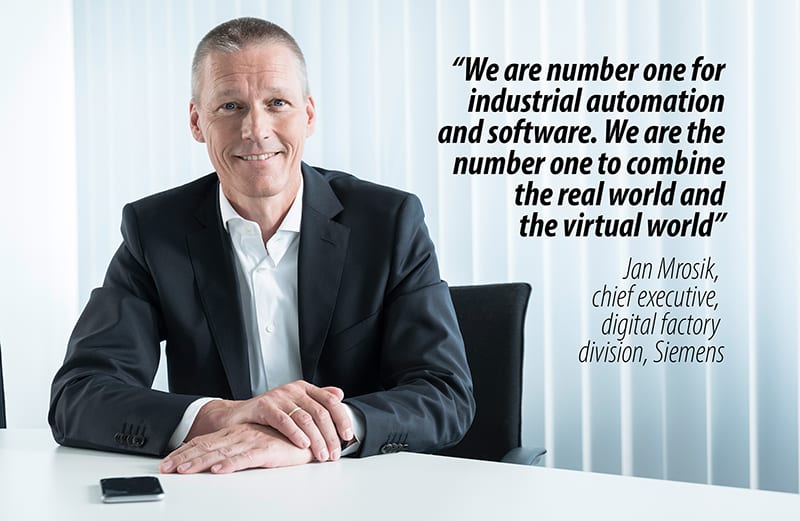Siemens made its case this week as the global leader for Industry 4.0 at a pre-show meet ahead of Hannover Messe 2019. The German industrial powerhouse suggested it has the form, momentum, and strategy to deliver industrial transformation on a grander scale than rival firms.
It has the industrial heritage, already, and has acquired new digital expertise as part of a carefully executed buying spree during the last few years. The company has tested its digital portfolio on its own factories, and honed its strategy and solutions accordingly. Siemens is the real deal, it implied, in a market full of pretenders.
“We know about automation, we are number one in the market, and the worlds of software and automation are coming together,” said Jan Mrosik, chief executive of the company’s digital factory division, in an address to European press and analysts at the Erlangen summit. “That’s why we started our digital portfolio way back, and why we have invested more than €10 billion in it. We are now number one for both automation and industrial software. We are the number one to combine the real world and the virtual.”
In a split-out session in Erlangen, later, Mrosik commented: “Digitisation looks easy on paper. In fact, it is something you need to plan and implement meticulously – in real-world environments, on a real shop-floor, with real people and competencies. That’s the art [of digital transformation]. And that’s distinguishes us from others – which might have done on Powerpoint, but not in real life.”
As a brief aside, addressing the question of industrial 5G networks, Enterprise IoT Insights asked of Siemens’ position on the German government’s decision to offer 100MHz of prime 5G spectrum in the 3.4 to 3.8 GHz band (C-Band) – one quarter of the total spectrum available – to German industrialists. Mrosik was somewhat evasive, but acknowledged the importance of the technology and the decision.
“5G is a very important technology going forward – it will provider higher bandwidth, lower latency, quality of service, and lots of features that are very important for industry. And it will ease a way of connectivity for machines,” he said.
“In Germany, politicians have taken a very important decision, that 100MHz of spectrum will be reserved for industrial usage – not as part of the spectrum to be auctioned, but to be available to those who own property, and have industrial usage of it. And that is an opportunity to deploy 5G – for either the company itself, which is possible, or for an operator [on behalf of industry], or a third party that will [offer it] as a service.”
 Would Siemens, with its history in network operations and its move to sell transformation-as-a-service, be interested to manage private 5G networks for the enterprises it is looking to serve with digital solutions? “We will provide 5G ready and capable products for industrial communication. That’s our role, that’s our job; we will of course provide consultancy as well because that’s part of what we are doing,” he said.
Would Siemens, with its history in network operations and its move to sell transformation-as-a-service, be interested to manage private 5G networks for the enterprises it is looking to serve with digital solutions? “We will provide 5G ready and capable products for industrial communication. That’s our role, that’s our job; we will of course provide consultancy as well because that’s part of what we are doing,” he said.
It was non-committal; the Erlangen discussion, also taking in a tour of the company’s local factory setup, stuck to the story of Siemens’ own transformation as the leading digital change agent for industry.
“Customers’ expectations are manifold and rising – especially with regards to speed, flexibility, lot-size of one. Products are being customised individually, quality is primordial, and efficiency is key – how to use resources in the best way,” said Mrosik, adding mention of environmental and security considerations in the future factory operations.
Siemens’ ‘digital factory’ IoT and automation division has been a boon for the company recently, with profits jumping 28 per cent in the fourth quarter, leaving the company about all-square in the last financial year. The company has recently bundled a number of edge devices running artificial intelligence (AI) applications into its digital enterprise portfolio, and bolstered its partner activity and support around its MindSphere platform alongside.
To be continued (after MWC)… Subscribe to the newsletter to get the next instalment.

